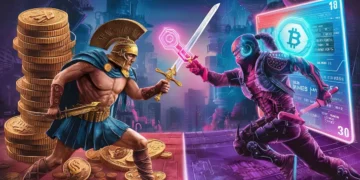Tether has launched its USD₮ stablecoin natively on the Kaia blockchain, enabling integration directly within LINE Messenger— one of Asia’s top messaging app with nearly 200 million monthly users. This move is expected to support broader stablecoin adoption in the region by making digital assets accessible through familiar platforms.
Key Takeaways
-
Tether’s USD₮ is now natively supported on the Kaia blockchain, which powers LINE’s decentralised applications.
-
LINE users—numbering over 200 million—can send, receive, and earn stablecoins within the app.
-
Stablecoin adoption is increasing in Asia, with countries like Thailand, Taiwan, and Indonesia seeing early growth.
-
The integration supports low-cost, near-instant cross-border transactions and provides entry to decentralised finance (DeFi).
-
LINE’s role may evolve toward enabling broader Web3 access through digital currency integration.
What Is Stablecoin Adoption and Why It Matters in Asia
Stablecoin adoption refers to the growing use of blockchain-based currencies pegged to stable assets—usually the U.S. dollar. Unlike more volatile cryptocurrencies, stablecoins like USD₮ offer a steady value, making them better suited for practical uses like payments, remittances, and savings.
Asia offers a favourable environment for this growth, thanks to its tech-savvy population and expanding fintech infrastructure. In regions where banking systems can be less accessible or more costly, such tools provide an alternative pathway to financial services.
How LINE and Kaia Simplify Access to Stablecoins
The integration of USD₮ into LINE Messenger through the Kaia blockchain changes the user experience by allowing stablecoin use within an app that many already engage with daily. Here’s what that includes:
-
Peer-to-Peer Transfers: Users can exchange USD₮ within LINE’s in-app wallet, making digital payments easier to manage.
-
In-App Payments and Rewards: Mini Dapps within LINE allow users to pay for services or earn tokens through engagement-based activities.
-
Cross-Border Transactions: With quick settlement times and low fees on the Kaia blockchain, users may benefit from more efficient international money transfers.
-
DeFi Participation: For users new to crypto, features such as lending and liquidity pools become more accessible. These tools allow users to earn returns or provide digital asset liquidity in decentralised environments.
This approach aims to reduce the learning curve and barriers typically associated with digital assets.
Real-World Impact: What This Means for 200 Million Users
The integration of USD₮ within LINE Messenger via Kaia could expand financial functionality for millions of users. With over 35 million already active in Mini Dapps, the presence of a stable, dollar-linked asset may make transfers and payments more straightforward.
LINE’s self-custodial wallet has been designed with ease of use in mind, potentially making digital assets more approachable to newcomers.
In areas with limited access to formal banking, such as parts of Thailand and Indonesia, digital stablecoins might offer an alternative for everyday financial activities.
However, users should be aware of risks such as changing regulations, the technical learning curve, and the responsibility of managing their wallets. These factors could impact adoption and user confidence.
Frequently Asked Questions (FAQ)
What is Kaia blockchain?
Kaia is a Layer 1 blockchain built to support LINE’s Web3 applications. It focuses on low transaction latency and near-instant finality.
How does this integration affect stablecoin adoption in Asia?
It broadens access by embedding stablecoins in a popular messaging platform, which may lower entry barriers to digital asset use.
Is this integration safe for users unfamiliar with crypto?
LINE’s self-custodial wallet is designed with user experience in mind. Still, like all crypto tools, users must understand key aspects of security and private key management.
Can USD₮ be used for shopping or other real-life payments within LINE?
Yes. Some Mini Dapps allow for payments, and additional use cases—such as recurring services or merchant tools—are expected to emerge over time.
What makes stablecoins more practical than traditional cryptocurrencies?
Their stable value makes them more suitable for payments, remittances, and savings compared to more volatile digital currencies.
Conclusion
The launch of USD₮ on LINE Messenger via the Kaia blockchain represents a noteworthy step in digital currency adoption in Asia. By incorporating stablecoins into a widely used app, the integration lowers some of the traditional barriers to entry into Web3.
While it offers convenience and potential access to financial tools, broader adoption will depend on user education, regulatory developments, and long-term usability.
Tether has launched its USD₮ stablecoin natively on the Kaia blockchain, enabling integration directly within LINE Messenger— one of Asia’s top messaging app with nearly 200 million monthly users. This move is expected to support broader stablecoin adoption in the region by making digital assets accessible through familiar platforms.
Key Takeaways
-
Tether’s USD₮ is now natively supported on the Kaia blockchain, which powers LINE’s decentralised applications.
-
LINE users—numbering over 200 million—can send, receive, and earn stablecoins within the app.
-
Stablecoin adoption is increasing in Asia, with countries like Thailand, Taiwan, and Indonesia seeing early growth.
-
The integration supports low-cost, near-instant cross-border transactions and provides entry to decentralised finance (DeFi).
-
LINE’s role may evolve toward enabling broader Web3 access through digital currency integration.
What Is Stablecoin Adoption and Why It Matters in Asia
Stablecoin adoption refers to the growing use of blockchain-based currencies pegged to stable assets—usually the U.S. dollar. Unlike more volatile cryptocurrencies, stablecoins like USD₮ offer a steady value, making them better suited for practical uses like payments, remittances, and savings.
Asia offers a favourable environment for this growth, thanks to its tech-savvy population and expanding fintech infrastructure. In regions where banking systems can be less accessible or more costly, such tools provide an alternative pathway to financial services.
How LINE and Kaia Simplify Access to Stablecoins
The integration of USD₮ into LINE Messenger through the Kaia blockchain changes the user experience by allowing stablecoin use within an app that many already engage with daily. Here’s what that includes:
-
Peer-to-Peer Transfers: Users can exchange USD₮ within LINE’s in-app wallet, making digital payments easier to manage.
-
In-App Payments and Rewards: Mini Dapps within LINE allow users to pay for services or earn tokens through engagement-based activities.
-
Cross-Border Transactions: With quick settlement times and low fees on the Kaia blockchain, users may benefit from more efficient international money transfers.
-
DeFi Participation: For users new to crypto, features such as lending and liquidity pools become more accessible. These tools allow users to earn returns or provide digital asset liquidity in decentralised environments.
This approach aims to reduce the learning curve and barriers typically associated with digital assets.
Real-World Impact: What This Means for 200 Million Users
The integration of USD₮ within LINE Messenger via Kaia could expand financial functionality for millions of users. With over 35 million already active in Mini Dapps, the presence of a stable, dollar-linked asset may make transfers and payments more straightforward.
LINE’s self-custodial wallet has been designed with ease of use in mind, potentially making digital assets more approachable to newcomers.
In areas with limited access to formal banking, such as parts of Thailand and Indonesia, digital stablecoins might offer an alternative for everyday financial activities.
However, users should be aware of risks such as changing regulations, the technical learning curve, and the responsibility of managing their wallets. These factors could impact adoption and user confidence.
Frequently Asked Questions (FAQ)
What is Kaia blockchain?
Kaia is a Layer 1 blockchain built to support LINE’s Web3 applications. It focuses on low transaction latency and near-instant finality.
How does this integration affect stablecoin adoption in Asia?
It broadens access by embedding stablecoins in a popular messaging platform, which may lower entry barriers to digital asset use.
Is this integration safe for users unfamiliar with crypto?
LINE’s self-custodial wallet is designed with user experience in mind. Still, like all crypto tools, users must understand key aspects of security and private key management.
Can USD₮ be used for shopping or other real-life payments within LINE?
Yes. Some Mini Dapps allow for payments, and additional use cases—such as recurring services or merchant tools—are expected to emerge over time.
What makes stablecoins more practical than traditional cryptocurrencies?
Their stable value makes them more suitable for payments, remittances, and savings compared to more volatile digital currencies.
Conclusion
The launch of USD₮ on LINE Messenger via the Kaia blockchain represents a noteworthy step in digital currency adoption in Asia. By incorporating stablecoins into a widely used app, the integration lowers some of the traditional barriers to entry into Web3.
While it offers convenience and potential access to financial tools, broader adoption will depend on user education, regulatory developments, and long-term usability.





















































































İstanbul da su kaçak tespiti Mutfaktaki su sızıntısının kaynağını termal kamerayla buldular. Tezgaha zarar vermeden tamir ettiler. Şükran D. https://lacataora.com/?p=303
facebook ad accounts for sale buying facebook account
get clomid prices cost of generic clomid without rx cost of clomiphene without prescription how to buy generic clomiphene buying cheap clomid tablets cheap clomid online clomid generico
I couldn’t hold back commenting. Warmly written!
More posts like this would persuade the online space more useful.
azithromycin 500mg uk – ciplox 500mg drug buy metronidazole tablets
semaglutide 14mg ca – cheap periactin 4 mg order generic cyproheptadine 4 mg
domperidone 10mg uk – flexeril price how to get cyclobenzaprine without a prescription
purchase amoxiclav – https://atbioinfo.com/ acillin canada
generic nexium 40mg – https://anexamate.com/ buy esomeprazole sale
buy cheap warfarin – https://coumamide.com/ buy cheap generic cozaar
mobic oral – mobo sin meloxicam 7.5mg usa
order deltasone online – apreplson.com cheap deltasone 20mg
free samples of ed pills – fast ed to take top rated ed pills
buy amoxil pill – https://combamoxi.com/ buy amoxil for sale
order forcan – this oral fluconazole 100mg
cenforce over the counter – order cenforce for sale purchase cenforce pill
cialis premature ejaculation – https://ciltadgn.com/# trusted online store to buy cialis
order zantac 150mg pill – https://aranitidine.com/ zantac 300mg without prescription
cialis from mexico – where to get free samples of cialis cialis going generic
More posts like this would create the online time more useful. this
order viagra pills online – https://strongvpls.com/ buy sildenafil citrate tablets 100mg
With thanks. Loads of erudition! https://buyfastonl.com/amoxicillin.html
I couldn’t hold back commenting. Adequately written! https://ursxdol.com/cenforce-100-200-mg-ed/
More articles like this would make the blogosphere richer. https://prohnrg.com/product/atenolol-50-mg-online/
This is the gentle of writing I rightly appreciate. on this site
I’ll certainly carry back to be familiar with more. https://ondactone.com/spironolactone/
More articles like this would frame the blogosphere richer.
https://proisotrepl.com/product/tetracycline/
This is the stripe of content I get high on reading. http://web.symbol.rs/forum/member.php?action=profile&uid=1170911
dapagliflozin online buy – https://janozin.com/ dapagliflozin pills
where can i buy orlistat – buy xenical online order xenical 120mg online cheap
More posts like this would bring about the blogosphere more useful. https://myrsporta.ru/forums/users/gknku-2/